Columbia Elizabeth
The Columbia Elizabeth is a barge designed to carry shipping containers.[1][2] She was launched in 1999, for Columbia Coastal Transport. The vessel's IMO number is 8639132. Her capacity is 912 TEU standard containers. When she was built she was one of the largest container barges ever built. Workboat magazine described her deck area as "the size of a football field".[3]

Forty-foot containers are stacked in seven rows, up to six containers high, and eleven containers across.[3]
On December 6, 2015, the Columbia Elizabeth was being towed south, by the Capt. Latham, near Port Canaveral, Florida, when crew members noticed she was missing some shipping containers.[4] She was diverted to the Port of Palm Beach where it was determined 25 shipping containers were missing. The Margaret Norvell, and other elements of the Coast Guard, were assigned to look for the missing containers.[5] One container washed ashore near Port Canaveral. Some of the missing containers contained electric batteries, a cargo that is considered toxic.[6]
References
- "Columbia Coastal Christens Super Barge". Marine Link. 2000-01-05. Retrieved 2015-12-08.
-
"Container super-barge enters service". Marine Log. 2004-07-07. Retrieved 2015-12-08.
Based in Liberty Corner, NJ, Columbia Coastal Transport operates 11 U.S.-flag container barges in regularly scheduled feeder service operations to and from ports on the U.S. Atlantic coast, plus Freeport Bahamas.
-
Kathy Bergren Smith (2008-11-01). "Feeding Time". Workboat magazine.
At 393' × 94' × 21', the barge Columbia Elizabeth is the size of a football field. Only this field floats and is stacked with containers. When fully loaded, the barge hauls 912 TEUs (20' equivalent units) stacked five, sometimes six, high and 11 across.
- "Coast Guard Responds To Overboard Cargo Containers". CBS News. 2015-12-06. Retrieved 2015-12-08.
- "COAST GUARD RESPONDING TO CARGO CONTAINER INCIDENT". United States Coast Guard News. 2015-12-06. Retrieved 2015-12-08.
-
"Hunt continues for cargo containers lost off Florida's coast". Sun Sentinel. 2015-12-08. Retrieved 2015-12-08.
Just how many batteries ended up in the water, what kind of batteries they are and where they end up could determine whether they could be an environmental risk to the ocean waters and marine life off Florida's coast, officials said.